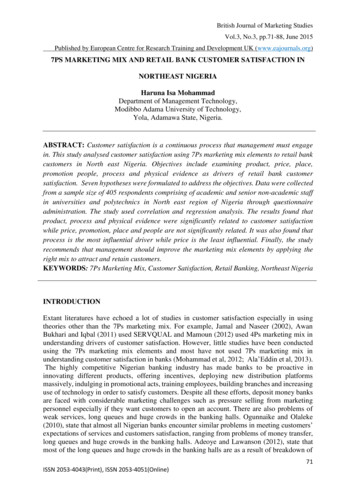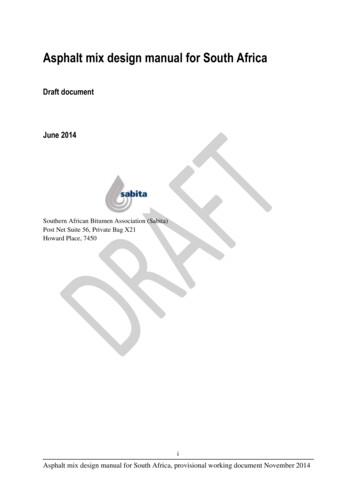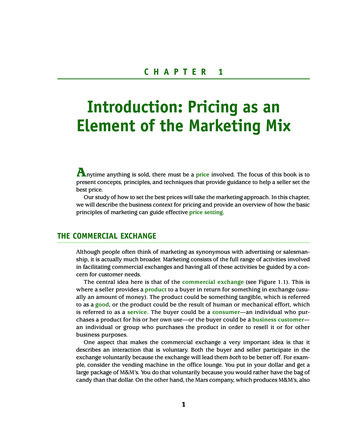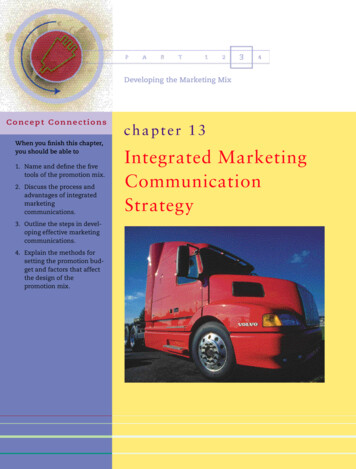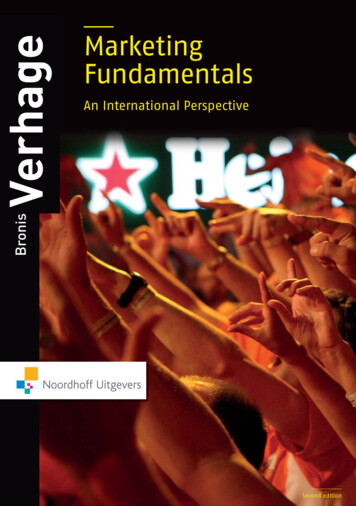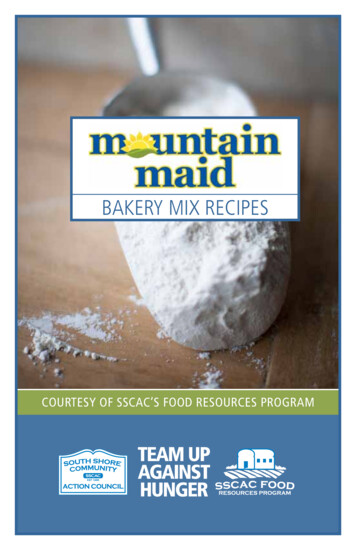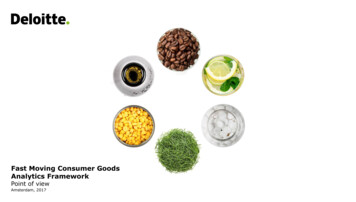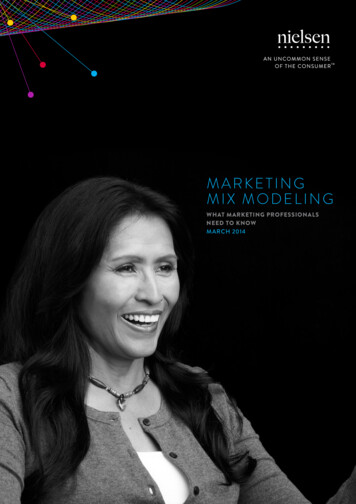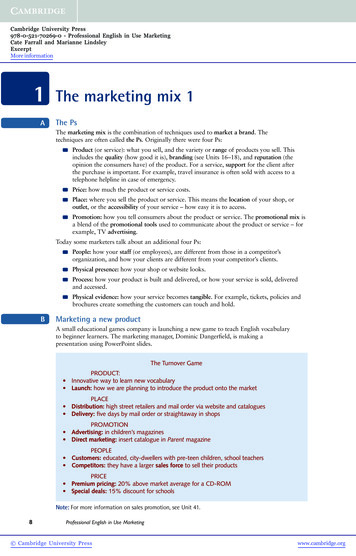
Transcription
Cambridge University Press978-0-521-70269-0 - Professional English in Use MarketingCate Farrall and Marianne LindsleyExcerptMore information1AThe marketing mix 1The PsThe marketing mix is the combination of techniques used to market a brand. Thetechniques are often called the Ps. Originally there were four Ps:Product (or service): what you sell, and the variety or range of products you sell. Thisincludes the quality (how good it is), branding (see Units 16–18), and reputation (theopinion the consumers have) of the product. For a service, support for the client afterthe purchase is important. For example, travel insurance is often sold with access to atelephone helpline in case of emergency.Price: how much the product or service costs.Place: where you sell the product or service. This means the location of your shop, oroutlet, or the accessibility of your service – how easy it is to access.Promotion: how you tell consumers about the product or service. The promotional mix isa blend of the promotional tools used to communicate about the product or service – forexample, TV advertising.Today some marketers talk about an additional four Ps:People: how your staff (or employees), are different from those in a competitor’sorganization, and how your clients are different from your competitor’s clients.Physical presence: how your shop or website looks.Process: how your product is built and delivered, or how your service is sold, deliveredand accessed.Physical evidence: how your service becomes tangible. For example, tickets, policies andbrochures create something the customers can touch and hold.BMarketing a new productA small educational games company is launching a new game to teach English vocabularyto beginner learners. The marketing manager, Dominic Dangerfield, is making apresentation using PowerPoint slides.The Turnover GamePRODUCT: Innovative way to learn new vocabulary Launch: how we are planning to introduce the product onto the marketPLACE Distribution: high street retailers and mail order via website and catalogues Delivery: five days by mail order or straightaway in shopsPROMOTION Advertising: in children’s magazines Direct marketing: insert catalogue in Parent magazinePEOPLE Customers: educated, city-dwellers with pre-teen children, school teachers Competitors: they have a larger sales force to sell their productsPRICE Premium pricing: 20% above market average for a CD-ROM Special deals: 15% discount for schoolsNote: For more information on sales promotion, see Unit 41.8Professional English in Use Marketing Cambridge University Presswww.cambridge.org
Cambridge University Press978-0-521-70269-0 - Professional English in Use MarketingCate Farrall and Marianne LindsleyExcerptMore information1.1A marketing manager is talking about the marketing mix for a brand of cleaningproducts. Choose the correct words from the brackets to complete the text, and thenmatch each speech bubble with one of the Ps. Look at A opposite to help you.123451.2Our (staff / reputation / competitors) are highly motivated. We really believe in our brand. Forexample, our (consumers / employees / customers) are always trying to improve what we do.Our (tools / range / support) includes detergent, toilet cleaner and sponges.We use a lot of (advertising / presence / promotional), usually in women’s magazines.You can find the brand in supermarkets and local shops. The (tangible / accessibility / process)of our (staff / mix / outlets) is important. We need to be in a lot of (locations / supports /distributions) so that we are easy to find.We are more (accessibility / reputation / expensive) than our (competitors / staff / sales) butwe offer good credit terms and we sometimes run special (deals / processes / support).Complete the text using words from the box. Look at A opposite to help you.advertisingmixpriceproductspromotionalMarie Curie Cancer Care is reviewing its marketing strategy in an attempt to attract awider audience. It will stop using (1)techniques, such as mailings and events.Television (2)and face-to-face marketing are both being tested in a bid tosupplement the charity’s typical over-60s donor base with younger supporters. If testsprove successful, they will become part of Marie Curie’s marketing (3).In addition, Marie Curie Cancer Care is expanding its online shop. Stylish handbags ata (4)of 10 are attractive to younger customers. Marie Curie Cancer Caresays it is responding to customers’ needs and wants by selling elegant fashionwear(5).1.3Do the following words and expressions refer to product, price, place, promotion, or people?Look at A and B opposite to help rsdeliverydirect tionqualityreputationPromotionsales forcespecial dealssupportPeopleOver to youThink about an expensive brand and a less expensive alternative – for example, Bang &Olufsen compared to Sony. What are the differences in the marketing mix for the two brands?Professional English in Use Marketing Cambridge University Press9www.cambridge.org
Cambridge University Press978-0-521-70269-0 - Professional English in Use MarketingCate Farrall and Marianne LindsleyExcerptMore information2AThe marketing mix 2The four Cs, As and OsSome marketers have supplemented the four Ps (see Unit 1) with new ways of thinking aboutmarketing. The Ps, Cs, As and Os can be combined when looking at the marketing mix.PromotionPlacePriceProduct4Ps4Cs4As4OsCustomer needsWhat does the customerneed to solve a problem? Forexample, people don’t havetime to cook – we offer thesolution of frozen dinners.AcceptabilityHow acceptable is theproduct, and do peopleapprove of the product?ObjectsWhat do you sell?How is it manufactured, ormade?Is it socially acceptable– fashionable andattractive?Is it a high quality (orexcellent) product, or is itbottom end?The company must identifycustomer needs so thatproducts that meet theseneeds can be developed (seeUnits 10–11).Cost to userDoes the customer perceivethe cost of the product asfair, or is it too expensive?Does the product respectthe laws of the country– is it legally acceptable?AffordabilityDoes the customer haveenough money to buythe product – can he /she afford the product?ObjectivesRevenue objectives concernthe income you want togenerate.ConvenienceHow convenient is it to findyour product? Is it easy, ordoes the customer have tomake an effort?AccessibilityIs the product easy toaccess?OrganizationHow should you organizethe sale and distribution ofyour product?CommunicationHow should youcommunicate with yourcustomers?AwarenessHow many people knowabout, or are aware of,the product?Is the product accessiblefor people withdisabilities?Is awareness high?Price objectives concern theprice you want to sell at.Which distributionmethods (see Unit 26) willwork best?OperationsWhich kind of promotionaloperations, such as directmail, will work best for theproduct? (See Units 32–43)Note: Customer or client? See Appendix I on page 108.BAIDAAIDA is an acronym which represents the steps a marketer takes in order to persuadecustomers to buy a product or service.10AttentionMarketing must first attract the customers’ attention to the product. Customersbecome aware of a product and know it is available.InterestThen, marketing must create an interest in the product. Customers will developan interest in the product.DesireNext, marketing must develop a desire to own or have the product so thatcustomers actively want the product.ActionFinally, marketing must prompt action to purchase, so that customers take stepsto buy the product – for example, by going to the shop or ordering it online.Professional English in Use Marketing Cambridge University Presswww.cambridge.org
Cambridge University Press978-0-521-70269-0 - Professional English in Use MarketingCate Farrall and Marianne LindsleyExcerptMore information2.1Put the words and expressions from the box into the correct columns. Look at A oppositeto help sscommunicationconvenienceproduct2.2cost to usercustomer lacepromotionComplete the article about a supermarket in-store event using words from the box. Lookat A opposite to help is week, Tesco launches its biggest ever ‘Health Event’ – illustrating its commitment tohelping (1)lead a healthy and active lifestyle. The supermarket has(2)health as an important customer concern and is working to(3)the needs of its customers.operations for healthy products will run all over the store,Hundreds of (4)from fresh produce through to grocery and healthcare lines. Tesco hopes that(5)of its initiative will be high.2.3Replace the underlined words and expressions with alternative words and expressionsfrom the box. Look at A opposite to help you.affordconvenienthigh qualitypricerevenue objectivessocially acceptable1 Mobile phones are fashionable and attractive to the youth market.2 We have a reputation for providing good standard mobile phones.3 The cost to user of mobile phones is kept down because they are subsidized by the networkproviders.4 This means more people can have the money to buy the product.5 More and more, customers buy mobile phones online because it is more accessible.6 Expected earnings from 3G phones were not met when the products were first launched.2.4Put the words in each sentence in the correct order. Look at B opposite to help you.1234567attention attract must product the to We.aware become of People brand the will.an create in interest need product the to We.an customers develop in interest product the to want We.a desire develop must our own product to We.People steps take it to try will.action buy must prompt it to We.Over to youThink about the most recent product you bought. Describe the marketing mix using the4Cs, the 4As or the 4Os.Professional English in Use Marketing Cambridge University Press11www.cambridge.org
Cambridge University Press978-0-521-70269-0 - Professional English in Use MarketingCate Farrall and Marianne LindsleyExcerptMore information3ASWOT analysisSWOT analysisBefore entering the marketplace it is essential to carry out a SWOT analysis. Thisidentifies the strengths and weaknesses of a product, service or company, and theopportunities and threats facing it. Strengths and weaknesses refer to the product itselfand are considered as internal factors. The external factors, referring to the marketplace,are opportunities and threats.This is a SWOT analysis of PetraServe, a company which runs motorway service stations.STRENGTHSWEAKNESSESSuperior distribution network – wehave one of the best.We are the specialist in longdistance petrol needs for lorry andtruck drivers – we have experience,knowledge and skill.Consumers see us as a quality brand.Innovative loyalty programme that’sunique in the market.We are a profitable company – we’remaking money.Highly recognizable brand.A global brand.Undifferentiated offer in terms of basicproduct – petrol is the same whateverthe brand.Lack of new products – we need more.Ineffective leverage of specialist image –we don’t use our specialist image well.Inferior communication – we couldcommunicate better.Damaged reputation for petrol and fossilfuels – they have a bad image.Consumer loyalty is weak.OPPORTUNITIESDeveloping market for service stationshop (confectionery, car maintenanceproducts, etc.).Gap in the market: hybrid cars andelectric cars will need fuel.Huge potential for growth – thereis a lot of room to expand into newmarkets.BTHREATSOur main competitor is strong.Price war in the fuel market is becomingmore threatening – all our competitorsare cutting prices.Emerging trend towards hybrid cars andelectric cars.Consumer fears about environment andpollution.SWOT and marketing strategyPat Albright is the senior marketing manager for PetraServe. She’s presenting hermarketing strategy to the board. The strategy was shaped by the SWOT analysis above.‘We need to exploit our strengths by making the most of our distribution network andloyalty programme. If we can also build on strengths such as our brand image andcurrent profitability, then it’ll be easier to address, or deal with, weaknesses such as thelack of new products. We need to anticipate the threat of new hybrid cars and seizethe new opportunities this will bring in terms of providing service points for these cars.The potential price war in the fuel market poses a serious threat and we will need tominimize the weaknesses this may create. Our sector is also under threat from the trendtowards greater consumer concerns about the environment, but I believe we can create anopportunity by strengthening our communication and informing consumers about whatwe’re doing to preserve the environment.’12Professional English in Use Marketing Cambridge University Presswww.cambridge.org
Cambridge University Press978-0-521-70269-0 - Professional English in Use MarketingCate Farrall and Marianne LindsleyExcerptMore information3.1The extracts below are from a SWOT analysis. Do they describe strengths, weaknesses,opportunities or threats? Look at A opposite to help you.13.2Competition is growing in this market, which could lead to a price war. There are nowa lot of sites that offer the same service and product categories as Amazon. Amazon isa global brand but in some local markets the main competitor could be stronger andpreferred by consumers.2Amazon has added a lot of new categories, but this may damage the brand. For example,offering automobiles may be confusing for customers. Due to increased competition, theoffer is undifferentiated.3In 2004 Amazon moved into the Chinese market. There is huge potential here. In 2005Amazon launched a new loyalty programme, AmazonPrime, which should maximizepurchases from the existing client base.4Amazon is a global brand, operating in over ten countries. It was one of the first onlineretailers and today it has an enormous customer base. It has built on early successes withbooks, and now has product categories that include jewellery, toys and games, food andmore. It has an innovative Customer Relationship Management programme.Complete the table with words from A and B opposite and related forms. Then completethe sentences below using words from the weaken1 Currently, the company is underfrom its main competitors.2 In order to grow, the company will have to create new, not just exploit existing.3 We need to minimizeand.4 To remain ahead of the competition we will need to anticipatesuch as increasedraw material costs.3.3Correct the mistakes using words and expressions from A and B opposite.1 The brand is very strengthened.2 Today, competitor fears about health are one of the biggest threats to the processed foodsector.3 An undifferentiated offer will weakness the company in the short term.4 A clear opportunity is a gape in the market.5 We may be threated by the emerging trend towards online shopping.6 A war of prices has weakened our profitability.Over to youThink about the company you work for, or one you would like to work for. Carry out a SWOTanalysis of the company. Do the same for a company you would never want to work for.Professional English in Use Marketing Cambridge University Press13www.cambridge.org
Cambridge University Press978-0-521-70269-0 - Professional English in Use MarketingCate Farrall and Marianne LindsleyExcerptMore information4AMarketing strategy and the marketing planMarketing strategy vs. marketing planA company’s marketing strategy describes how it will position itself and the products itsells or the services it provides in the competitive marketplace. The strategy includes adiscussion of target markets, product and pricing policies, and proposed marketing andpromotional initiatives (see Units 1–2 for more about the marketing mix).The company’s marketing plan is the written document which details the marketingmethods selected (advertising, price promotions, etc.) and specific marketing actions ormarketing activities (for example, a back-to-school promotional offer). It also examinesthe resources needed (both financial and human) to achieve specified marketing objectives,such as an increase in sales or a successful product launch, over a given period of time.BDeveloping the marketing planYou can develop a marketing plan using the stages known as AOSTC (Analysis,Objectives, Strategies, Tactics and Control).AnalysisCurrent marketsituationInformation on the competitors and the marketplace.CompetitoranalysisThe competition in the marketplace. You will also need toinclude information on their positioning – how they controlthe way the customers see the products or services.Product / serviceanalysisWhat you sell or provide, and your Unique Selling Point(USP) – that is, what distinguishes your product or servicefrom others on the market.Originally USP stood for Unique Selling Proposition, aconcept developed by Rosser Reeves in the 1940s.ObjectivesTarget marketYour customer groups or segments – for example,teenagers or business people (see Unit 19).Marketing goalsWhat you want to achieve, in terms of image and sales.Set SMARTobjectivesSpecific – Be precise about what you are going toachieve.Measurable – Quantify your objectives.Achievable – Are you attempting too much?Realistic – Do you have the resources to make theobjective happen (manpower, money, machines,materials, minutes)?Timed – When will you achieve the objective? (Withina month? By February 2015?)StrategiesThe approachto meeting theobjectivesWhich market segment?How will we target the segment?How should we position within the segment?TacticsConvert yourstrategy into themarketing mix,including the 4 PsProductPricePlacePromotionControlTrackingHow the success of the marketing plan will be measured (seeUnit 24). How each marketing activity will be assessed.A summary of the marketing plan, known as the executive summary, is included at thebeginning of the document. For a list of questions to ask when preparing a marketingplan, see Appendix II on page 109.14Professional English in Use Marketing Cambridge University Presswww.cambridge.org
Cambridge University Press978-0-521-70269-0 - Professional English in Use MarketingCate Farrall and Marianne LindsleyExcerptMore information4.1Make word combinations with market and marketing using words from the box. Thenmatch the word combinations with the definitions below. Look at the page opposite andAppendix II on page 109 to help eting1234564.2groups of consumers with similar needs or purchasing desiresthe consumers, clients or customers you want to attracta definition of the company, the product / service and the competitiondetailed information about how to fulfil the marketing strategythe techniques you can use to communicate with your consumersthe combination of different elements used to market a product or serviceYou are preparing some slides for a presentation of next year’s marketing plan. Choose atitle from the box for each image. Look at B opposite to help you.Competitor AnalysisTarget MarketUSP132Over to youThink about a product or service that you use every day. Answer the questions fromAppendix II on page 109 in relation to this product or service.Professional English in Use Marketing Cambridge University Press15www.cambridge.org
Cambridge University Press978-0-521-70269-0 - Professional English in Use MarketingCate Farrall and Marianne LindsleyExcerptMore information5AMarketing ethicsSocial marketingSocial marketing is the use of marketing techniques to convince people to change theirbehaviour for their own good or for the benefit of society. Encouraging smokers to stopsmoking or persuading people to eat more fresh fruit and vegetables are examples. Theaim of social marketing is to minimize social problems such as crime or poverty.BCorporate social responsibility (CSR)The advantages for a company of being socially responsible – that is, taking positiveactions for the benefit of its staff and society as a whole – include enhanced brand image,and greater ease in attracting staff. There are different ways for a company to showcorporate social responsibility (CSR).Cause related marketing (CRM) is when a company donates money to a charity, anon-profit organization or a good cause, such as UNICEF or Oxfam. The brand is thenassociated with the charity. For example, a US non-profit wild cat sanctuary, Big CatRescue, wants to create a marketing partnership with another organization:http://www.bigcatrescue.orgBig Cat Rescue is looking for the right corporate partner for a mutuallybeneficial cause related marketing campaign. We need financial donations to beable to afford to make our good work more effective. Today most of this fundingcomes from private individuals. We are looking for a corporate partner thatshares our principles and values.Note: The abbreviation CRM also refers to Customer Relationship Management – see Unit 23.Green marketing is the development and distribution of eco-friendly, or environmentallyfriendly, goods – for example, washing powder that is not harmful to the environment.6 degrees.ca is a Canadian web-based forum that promotes green marketing and environmentalprotection:6 degrees.ca believes that if a business is behaving in an ethical or moral way thenthey will contribute to environmental sustainability. Sustainable development isdevelopment that meets the needs of today without compromising the ability of futuregenerations to meet their needs. Responsible citizens are aware of environmentalconcerns such as global warming, and act to protect the environment.Responsible purchasing is another way that a company can build or maintain a goodreputation. Companies can refuse to buy materials or goods made using child labouror that have been tested on animals. As well as showing concern for human rights andanimal testing, a company can implement a policy of sustainable purchasing and only buyproducts that come from renewable sources.16Professional English in Use Marketing Cambridge University Presswww.cambridge.org
Cambridge University Press978-0-521-70269-0 - Professional English in Use MarketingCate Farrall and Marianne LindsleyExcerptMore information5.1Make word combinations using a word from eachbox. Two words can be used twice. Look at A andB opposite to help you.5.2Complete the texts describing examples of CSR. Then decide whether the companies areinvolved in CRM, green marketing or social marketing. Look at A and B opposite to gresponsiblesustainabilitytestingbIn 2008, we are proud to continue ourmarketing (1)with theArlette Foundation. We will promote the(2)in our stores and wewill sell a range of products displayingthe charity’s distinctive logo.For each product sold, we will(3)money to the ArletteFoundation, with a minimum(4)of 250,000. We arecommitted to being (5)responsible.The Push Play campaign in New Zealand hassuccessfully (6)New Zealanders todo more exercise. The campaign aimed to limitthe twin epidemics of obesity and diabetes,(7)problems now affectingcountries worldwide.cCASE STUDY: Woody Pens – Designed for theEnvironmentInstead of making its pens from plastic, GoodkindPen Company uses wood scraps from local furnituremakers, and its pens are designed to be refillable.By carefully designing its product to be eco(8)and of high quality, it is mutually(9)for the environment and theconsumer. Goodkind has made a product with asuper-green profile and, in the process, enjoys a highlevel of satisfaction from environmentally consciousconsumers and companies with a responsible(10)policy. Goodkind embracesenvironmental (11).5.3Complete the table with words from A and B opposite and related forms. Put a stressmark in front of the stressed syllable in each word. The first one has been done for etysociallysustainablyOver to youThink about the brands you buy. How does ethical marketing influence your purchasingdecisions?Professional English in Use Marketing Cambridge University Press17www.cambridge.org
Cambridge University Press978-0-521-70269-0 - Professional English in Use MarketingCate Farrall and Marianne LindsleyExcerptMore information6AThe market environmentThe micro environmentLearnmarketing.net provides information for marketing students. Its website says thefollowing about the micro environment:http://www.learnmarketing.netThe following factors have a direct impact on the company and its stakeholders: consumers,employees, shareholders and suppliers. The company has an influence over these factors.BconsumersA company must understand consumer needs and meet them.competitorsYou must differentiate your brand from your competitors’.employeesEmploying the right people and keeping them motivated is essential.Training and development play a key role in the service sector.mediaPositive or adverse (negative) media attention can seriously affect anorganization. Consumer programmes on TV and consumer magazinesthat people read have a powerful effect on the marketplace.shareholdersIt is important to satisfy shareholders’ needs without harming thebrand in the long term.suppliersChanges in the price or quality of raw materials – for example wood, ormetals – will affect the marketing mix. Good relations with suppliers willmake business easier.The macro environment: STEP analysisA STEP analysis (also known as a PEST analysis) looks at sociological, technological, economicand political factors in the market environment on a macro level – often looking at a particularcountry or region. The relationship between the company and these factors is indirect. This is aSTEP analysis for an online supermarket in Britain.SOCIOLOGICAL FACTORSDominant religions: Mainly Christian, with significant minorities in some regions.Special diets in some areas.Leisure activities: Watching TV, cooking, socializing.Gender roles: Now that younger men shop as much as women, we need to target both sexes equally.Birth rates: Birth rates are continuing to decline, with fewer babies born every year.Average life expectancy: This is increasing so we should think about products for older customers.Attitudes to foreign products: Consumers like to experiment with foreign food and drink.Opinions on environmental issues: We should use only recyclable packaging and hybrid-fuel delivery vans.TECHNOLOGICAL FACTORSInnovation and technological advances:Production: New product lines and product types are continually coming onto the market.Offer: We now offer a new service – ordering by mobile phone.Distribution: Online ordering has changed the way supermarkets operate. We no longer need actual shops.Communication with consumers: Broadband internet connections make it possible to include more productphotos on our site. We could even think about adding video.ECONOMIC FACTORSThe economic forecast is good:Interest rates: stable at 5%Unemployment rate: less than 9% of people are out workGDP (Gross Domestic Product): growing steadilyPOLITICAL FACTORSPolitical stability: Very good. Consumers feel relaxed about the political situation and ready to use consumercredit.New tax / business legislation: No changes to the law for our business sector in the near future.International trade agreements: We can import products from the EU without paying extra import duties.18Professional English in Use Marketing Cambridge University Presswww.cambridge.org
Cambridge University Press978-0-521-70269-0 - Professional English in Use MarketingCate Farrall and Marianne LindsleyExcerptMore information6.1Decide whether the following market environment characteristics are micro factors ormacro factors. Look at A and B opposite to help you.MicroMacro1 High unemployment in a region reduces spending on leisure activities.2 The internet has opened up new distribution and marketing channels.3 Good relations between a supplier and a company mean that goods arealways delivered on time.4 Legislation in European countries is restricting the right to smoke inpublic places.5 Positive reports in the national press about a brand.6 The staff for the telephone hotline of an internet bank are trained to bepolite and friendly.7 During the FIFA World Cup, more snack food is consumed in front ofthe TV set.6.2Complete the action plans (1–6) and then match them with the micro factors (a–f). Lookat A opposite to help you. The first one has been done for you.satisfy1 Convince shareholders that the best way totheir needs in the long term is toinvest in research and development.2 Carry out market research to betterneeds and desires.3 Prepare a press release for amagazine about the launch of a new product.4 Build and maintain goodby always paying on time.5 Do a SWOT analysis to assess how toyour brand from your competitors’.6 Implement a training andplan to motivate and keep good members.a competitorsb consumers6.3c employeesd mediae shareholdersf suppliersComplete the STEP analysis of France. Look at B opposite to help you.France is a member of the European Union and as such has trade (1)the other members. It has one of the worst unemployment (2)and the government is keen to bring this down.within Europerates in Europe (1.9 children per woman)France has one of the highest (3)and a large proportion of French mothers go back to work, reflecting changes in(4)roles. Men are almost as likely as women to do the shopping for thefamily and take care of the children.The dominant (5)is Catholicism, but there is a large Muslim community.The religious beliefs do not significantly affect the marketplace, except at Christmas andEaster time when the demand for Christmas trees and chocolate increases dramatically.Internet penetration is high: most households own a computer and have high speedand there are nowinternet acc
advertising mix price products promotional Marie Curie Cancer Care is reviewing its marketing strategy in an attempt to attract a wider audience. It will stop using (1) techniques, such as mailings and events. Television (2) and face-to-face marketing

